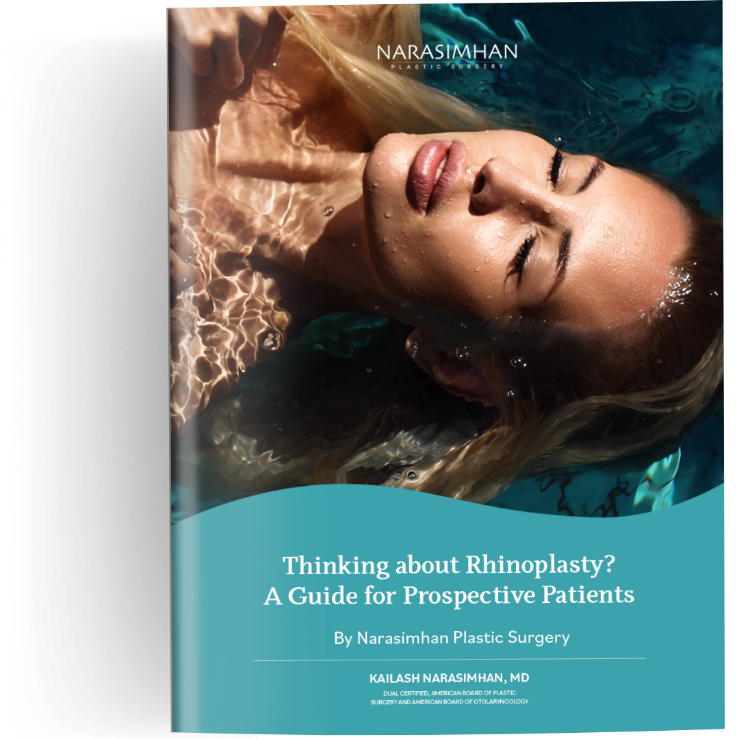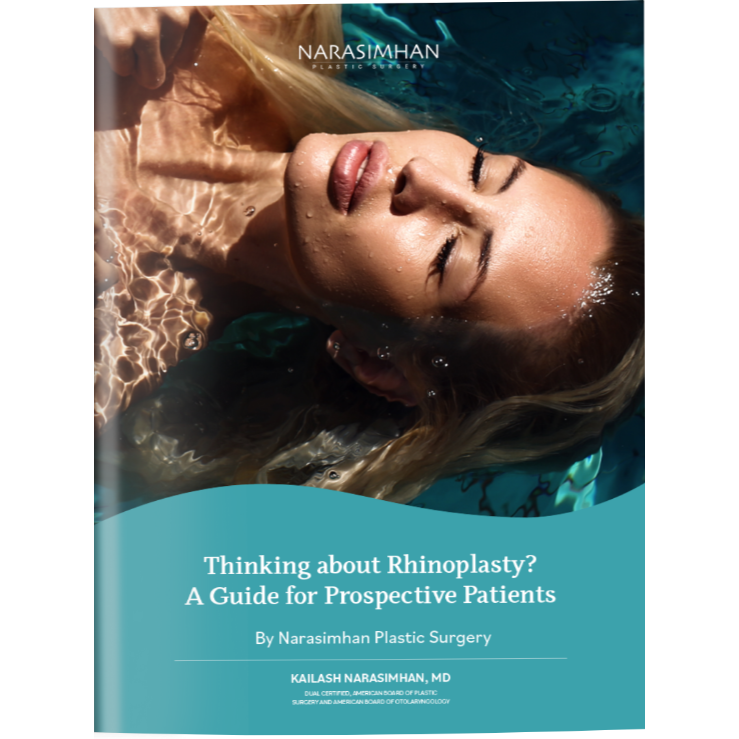Narasimhan Plastic Surgery: Kailash Narasimhan, M.D.
900 Carillon Pkwy., Ste. 409
St Petersburg, FL 33716
Phone: (727) 289-7119
Monday–Friday: 8:30 a.m.–4:30 p.m.
Ethnic Rhinoplasty in Tampa & St. Petersburg
Non-Caucasian patients often aren’t well-served by rhinoplasty techniques developed in the United States, which are focused on the general facial shapes and cosmetic standards of people of Western European origin. Double board-certified plastic surgeon Dr. Kailash Narasimhan understands the unique diversity of facial shapes within each ethnic group, and tailors rhinoplasty to address each individual’s concerns.
To meet with ethnic rhinoplasty specialist Dr. Kailash Narasimhan, request a consultation using the online form or call (727) 289-7119 to schedule an appointment. People come to his practice in St. Petersburg for ethnic rhinoplasty from Clearwater, throughout the Tampa region, and beyond.
What Is Ethnic Rhinoplasty?
Ethnic rhinoplasty is an umbrella term that encompasses nasal reshaping procedures for non-Caucasian patients. Rhinoplasty, often called a “nose job,” is one of the most common cosmetic procedures performed each year in the United States. People of all ethnicities may feel the shape or size of their nose detracts from their overall appearance.
Within different ethnic groups, there are unique physical characteristics that a surgeon should consider when creating a surgical plan. Applying Caucasian rhinoplasty techniques to the face of an African American, Asian, Hispanic, Middle Eastern, or Indian patient may result in potential breathing issues and an increased risk of needing multiple or revisional surgeries.
A Must-Have Guide to Rhinoplasty
Your path to a successful rhinoplasty and getting the nose of your dreams starts with downloading Dr. Narasimhan’s free e-guide, Your Guide to Rhinoplasty. The informative, easy-to-read guide includes information you need to know about the consultation process and what to expect before, during, and after surgery. It also features before and after photos of Dr. Narasimhan’s rhinoplasty patients.


How Much Does Ethnic Rhinoplasty Cost in the Tampa-St. Petersburg Area?
Ethnic rhinoplasty requires technical expertise that not all plastic surgeons possess. The physician fees for rhinoplasty range from $5,000 to $6,000, depending on the specific needs of each patient. We cannot quote a specific price without an in-person consultation. Dr. Narasimhan understands that cost is a factor for most rhinoplasty patients, but price should not be the primary issue in your choice of surgeon. We assist patients by offering financing through PatientFi, an organization that specializes in elective healthcare financing.
Four Common Shared Concerns
Patients of all ethnicities tend to have 4 concerns about the appearance of their noses that lead them to consider rhinoplasty:
Bulbous tip: A large, fleshy end of the nose
Flat or broad tip: Internal cartilage is spread too far apart, creating a wide tip
Wide, narrow, or humped bridge: A nasal bridge with a hump, or that is too narrow or large
Breathing problems: Structural issues such as a deviated septum that makes it difficult to breathe
For each ethnicity, surgeons take into account unique characteristics.
Dedicated to Your Care
DOUBLE BOARD-CERTIFIED PLASTIC SURGEON
Dr. Narasimhan is an excellent choice for your cosmetic procedure for many reasons, including:
- Double board certified by the American Board of Plastic Surgery and the American Board of Otolaryngology
- Highly trained in procedures of the face, breast, and body
- Passion for cosmetic procedures and patient care
- Compassionate care and attention to detail


Asian Rhinoplasty
The nationality of the patients matters when devising Asian rhinoplasty surgical plans. There are differences between Korean, Japanese, Chinese, Vietnamese, Cambodian, and Thai patients. That said, there are some specific concerns that are common for Asian rhinoplasty patients. These include:
- Flat nasal bridge
- Larger nasal tip
- Wide nasal bridge and tip
- Under-projected nose or tip
- Bumpy nasal profile
In all cases, we start by discussing your goals and incorporate computer simulation as part of the consultation process, which helps communicate your potential results following rhinoplasty surgery.
Asian Rhinoplasty Techniques
Dr. Narasimhan often uses grafted cartilage to add projection, elevate the bridge, or refine the nasal tip. He makes the base of the nose smaller, sometimes making incisions on the side (alar base reduction). In some cases, he may narrow the nasal bones or use a specialized grafting technique using ear cartilage for subtle augmentation.
Asian rhinoplasty also takes into account the unique cultural standards within this group of patients. For example, many East Asian patients want longer noses with more projection. Southeast Asian patients, on the other hand, often have sufficient nasal length or height.
African American Rhinoplasty
Our practice treats African American rhinoplasty patients as well as patients from African countries, such as Kenya, South Africa, Ghana, and Ivory Coast. Many of these patients have thicker nasal skin and darker skin tones, with smaller internal structures. Specific concerns shared by African American rhinoplasty patients include:
- Wide nasal bridge
- Flat nasal bridge
- Wide tip and wide nasal base
- Droopy tip
- Concern about keloid scarring
As with other rhinoplasty patients, reviewing a computer simulation showing potential results is part of the consultation process.
African American Rhinoplasty Techniques
Rhinoplasty surgery for African American patients typically involves using grafted rib cartilage to augment either the bridge of the nose or the nasal tip. It’s important that the surgeon uses techniques that address the thicker skin. Thinning the skin helps define and soften the tip. Depending on the tip’s anatomic structure, the nostrils can be wider and flared, requiring specialized surgical maneuvers to address.
Scarring is a concern for many African American patients. Even though scars may be initially hyperpigmented and thick they do settle appropriately with time. Keloids are extremely uncommon. Another thing to keep in mind is that it may take longer for the nose to heal and swelling to subside after African American rhinoplasty.
Middle Eastern/Indian Rhinoplasty
Patients with Middle Eastern backgrounds encompass a large geographic area. It may include Arab and North African patients, who have many similarities to patients of Indian origin. They often have thicker, more sebaceous (oily) skin with darker skin complexions. Common concerns about the nose for these patients include:
- Large, bulbous tip
- Dorsal hump (on the nasal bridge)
- Droopy nasal tip (tip ptosis)
- Overprojected nose
Again, we have patients look at computer simulations to get a glimpse at possible results to help them communicate their goals during the consultation.
Middle Eastern/Indian Rhinoplasty Techniques
Each patient is different, and it is important to use our specialized rhinoplasty techniques in a sophisticated and nuanced way. This means preserving the natural anatomy of the nose and not “overdoing” it. For patients concerned about a nasal hump, Dr. Narasimhan specializes in ultrasonic rhinoplasty, using a specialized device that smooths the hump in a gentler way that reduces recovery time. Other techniques include grafting to add length to the nose, tip rotation, and thinning nasal skin, if needed.
Hispanic Rhinoplasty
Dr. Narasimhan’s rhinoplasty patients include many Hispanic men and women encompassing an extremely diverse ethnic variation, depending on their origin. They may have Mexican, Puerto Rican, Cuban, Dominican, South American, or Central American roots. Cross-cultural influences from Spain (Castilian), Italy, and Portugal are also common. This diversity means Hispanic rhinoplasty patients often have very different needs. That being said, some of their common aesthetic concerns include:
- Nasal hump
- Droopy tip
- Overprojected nose
- Enlarged tip
Using computer simulation, we can provide patients with a look at possible results and help clarify their cosmetic goals during the consultation process.
Hispanic Rhinoplasty Techniques
The diverse backgrounds of Hispanic patients mean they may have either thin or thick nasal skin. More complicated rhinoplasty surgery involves patients with thick skin and weak cartilage structure, along with a shorter septum. Dr. Narasimhan uses techniques that maintain the patient’s ethnicity, so the results look natural. Our goal is to produce the best version of the patient’s nose, creating harmony among facial features.
If a patient wants to reduce the size of nasal hump, Dr. Narasimhan specializes in ultrasonic rhinoplasty, an advanced technique that reduces recovery time.
For Hispanic patients with thicker skin and weaker cartilage, cartilage grafting, and structure are important. Often the septal cartilage is weak or small, and Dr. Narasimhan uses other grafting materials. It can also take longer to heal for patients with thick skin.
Visit our St. Petersburg practice to learn more about ethnic rhinoplasty by requesting a consultation using the online form, or call our office at (727) 289-7119 to schedule an appointment.







